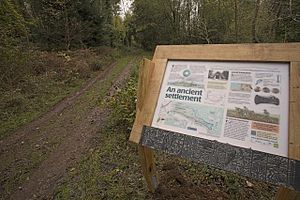Cleeve Toot facts for kids
 |
|
| Location | near Cleeve and Nailsea |
|---|---|
| Region | Somerset, England |
| Coordinates | 51°23′14″N 2°46′23″W / 51.38722°N 2.77306°W |
| Type | univallate hill fort |
| History | |
| Periods | Iron Age |
| Site notes | |
| Condition | destroyed |
Cleeve Toot is an ancient hill fort located above Goblin Combe, near Cleeve, Somerset, England. It was built during the Iron Age, a time when people started using iron tools and weapons. This fort is a "univallate hill fort," which means it had a single main wall or rampart for defense. Today, Cleeve Toot is a Scheduled Ancient Monument, meaning it's a special historical site protected by law.
The fort is shaped roughly like an oval. It measures about 125 meters (410 feet) long and 90 meters (295 feet) wide. About 150 meters (492 feet) north of Cleeve Toot, there's another, smaller ancient settlement. Experts believe these two sites might have been connected to a larger community at nearby Cadbury Hill.
Archaeologists have found pits at Cleeve Toot. These pits suggest that people lived here in round houses. The fort had one stone rampart, which was a large bank of earth and stones, with a wide, shallow ditch outside it. There are also signs of an old field system, possibly from prehistoric times or the Roman era.
What is a Hill Fort?
Hill forts were large, fortified settlements built on hills. They became common in Britain during the Late Bronze Age and Early Iron Age, around 1000 BC. People built them for different reasons. Some think they were military sites, used for defense against invaders. Others believe they were built because more people were living in the area, which put pressure on farming and led to conflicts.
Many experts now think that as iron became more widely used, it changed society. Iron ore was found in different places than the metals used for bronze (tin and copper). This shifted trade routes and changed who held power. Hill forts could have been places where communities gathered for protection when tensions grew. While some forts were attacked, their main purpose wasn't always just for war. They also served as important community centers.


